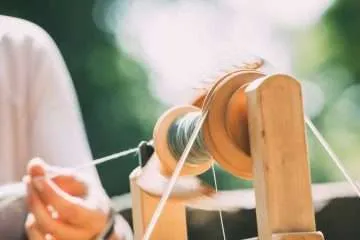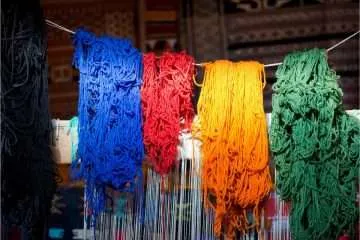The timeless practice of yarn spinning has enchanted people from diverse cultures for generations. Whether you’re an aspiring spinner wanting to immerse yourself in this captivating craft or an accomplished artisan seeking to broaden your skillset, comprehending the distinct spinning approaches and their specific uses is essential.
Within this Blog Post, i will examine three prominent spinning styles: Woolen, Worsted, and Navajo plying.
Woolen Spinning
Woolen spinning is a type of spinning that creates a soft, fluffy, and slightly fuzzy yarn. To create a woolen yarn, the fibers are carded (combed) and spun in a way that preserves the fibers’ natural crimp and loft.
This creates a yarn that is light and airy – with a lot of volume and bounce. One of the main characteristics of woolen yarn is that it has a lot of “air” in it, which makes it warm and insulating.
It’s also relatively stretchy and elastic, which makes it good for knitting or crocheting garments that need to stretch, such as hats, gloves, and sweaters.
Woolen yarn can be spun on a spinning wheel or a drop spindle, and it’s typically spun from fibers that have a naturally curly or crimpy texture, such as wool, alpaca, or mohair.
Worsted Spinning
Worsted spinning generates a sleek, sturdy, and glossy yarn. To produce a worsted yarn, fibers are carded and spun in a manner that aligns them parallelly, yielding a smooth and consistent texture in the yarn.
A primary attribute of worsted yarn is its strength and durability, making it well-suited for knitting or crocheting garments that endure frequent wear, such as socks, scarves, and blankets. Additionally, its relatively dense and heavy nature renders it suitable for items requiring a good drape, like shawls and wraps.
Worsted yarn can be crafted using a spinning wheel or a drop spindle and is generally spun from fibers with a naturally straight and smooth texture, including wool, silk, or cotton.
Navajo Plying
Navajo plying – alternatively known as chain plying, is a spinning technique that yields a dense, robust, and resilient yarn. In crafting Navajo-plied yarn, a spinner twirls a single yarn strand, then wraps it around a core strand to produce a multi-ply yarn.
A key feature of Navajo-plied yarn is its impressive strength and durability, making it well-suited for knitting or crocheting items that will experience significant wear, such as bags, belts, and laces.
Furthermore, its elasticity and bounciness render it ideal for garments that require stretching, including hats, gloves, and sweaters.
Navajo plying can be executed using a spinning wheel or a drop spindle, and it’s usually spun from fibers inherently strong and long-lasting, like wool, alpaca, and mohair
Choosing the Right Type of Spinning for Your Project
Having explored the various spinning methods – you may be contemplating which one is most suitable for your project.
Here are several factors to weigh when determining the optimal spinning approach:
- Fiber type: Distinct fibers possess unique properties, influencing their spinning behavior and the resulting yarn. For instance, wool generally spins effectively as woolen or worsted yarn, while silk and cotton are better suited for worsted spinning. Reflect on the fiber type you’ll be utilizing and its spinning characteristics.
- Project type: Different projects demand specific yarn qualities. A hat or sweater requiring warmth and insulation might be best paired with woolen yarn, while a sock or scarf needing strength and durability may benefit from worsted or Navajo-plied yarn. Contemplate the nature of your project and the desired yarn attributes.
- Personal preference: In the end, your spinning choice will largely be influenced by personal taste. Some spinners may favor the gentle, fluffy texture of woolen yarn, while others might appreciate the sleek, glossy texture of worsted yarn. Experiment with diverse spinning techniques to discover your preference.
In summary, woolen, worsted, and Navajo plying represent three prevalent spinning methods – each boasting distinct features.
By comprehending their differences, you can select the ideal spinning technique for your project, crafting a yarn that fulfills your requirements and preferences. Enjoy your spinning journey!
Read Also:
Buying Advice for a Spinning Wheel – a Comprehensive Guide!
A Fascinating History of Spinning Wool: From Ancient Civilizations to Modern Times
Spinning Yarn with Color: From Hand-Painting to Kettle-Dyeing
New to Spinning Yarn? Here are some Expert Tips for Beginners
Choosing Yarn for Your Spinning Project – What you should Consider?
Discover a History of Textile Manufacturing: Natural Fabrics like Wool, Coton, Silk and Beyond
Celebration of Craftsmanship and Contributions of the Women in Spinning Wool
Getting Started with Spinning: We will Introduce You in the Art of Yarn Making



0 Comments